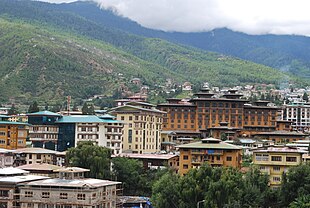Our website is made possible by displaying online advertisements to our visitors.
Please consider supporting us by disabling your ad blocker.
Economy of Bhutan
 Thimphu is the largest economic centre of Bhutan. | |
| Currency | ngultrum (BTN) Indian rupee (INR) |
|---|---|
| 1 July – 30 June | |
Trade organizations | SAFTA |
Country group |
|
| Statistics | |
| Population | |
| GDP |
|
| GDP rank | |
GDP growth |
|
GDP per capita |
|
GDP per capita rank | |
GDP by sector |
|
| 7.35% (2021)[4] | |
Population below poverty line | |
| 37.4 medium (2017, World Bank)[7] | |
Labor force | |
Labor force by occupation |
|
| Unemployment | |
Main industries | Cement, wood products, processed fruits, alcoholic beverages, calcium carbide, tourism |
| External | |
| Exports | |
Export goods | Iron and Steel, Salt Sulphur and Cement, Aircraft |
Main export partners | |
| Imports | |
Import goods | machinery, minerals, motor vehicles, metals |
Main import partners | |
FDI stock |
|
Gross external debt | |
| Public finances | |
| −3.4% (of GDP) (2017 est.)[3] | |
| Revenues | 655.3 million (2017 est.)[3] |
| Expenses | 737.4 million (2017 est.)[3][note 1] |
| Economic aid | $985 million (India) (2015-16) |
All values, unless otherwise stated, are in US dollars. | |
The economy of Bhutan is based on agriculture and forestry, which provide the main livelihood for more than 60% of the population. Agriculture consists largely of subsistence farming and animal husbandry. Rugged mountains dominate the terrain and make the building of roads and other infrastructure difficult. Bhutan is among the richest by gross domestic product (nominal) per capita in South Asia, at $3,491 as of 2022, but it still places 153rd, and among the poorest in the world. The total gross domestic product is only $2,653 million, and 178th according to IMF.
Bhutan's economy is closely aligned with India's through strong trade and monetary links and dependence on India's financial assistance. Most production in the industrial sector is of the cottage industry type. Most development projects, such as road construction, rely on Indian migrant labour. Model education, social, and environment programs are underway with support from multilateral development organisations.
Each economic program takes into account the government's desire to protect the country's environment and cultural traditions. For example, the government, in its cautious expansion of the tourist sector, encourages visits by upscale, environmentally conscientious tourists. Detailed controls and uncertain policies in areas such as industrial licensing, trade, labour, and finance continue to hamper foreign investment. Hydropower exports to India have boosted Bhutan's overall growth, even though GDP fell in 2008 as a result of a slowdown in India, its predominant export market.
Since 1961, the government of Bhutan has guided the economy through five-year plans in order to promote economic development.[15]
On 8 December 2023, Bhutan graduated from the UN's list of least developed countries (LDCs), making it only the 7th country to do so and the first in 3 years.[16][17]
- ^ "World Economic Outlook Database, April 2019". International Monetary Fund. Retrieved 29 September 2019.
- ^ "World Bank Country and Lending Groups". World Bank. Retrieved 29 September 2019.
- ^ a b c d e f g h i j k "The World Factbook". Central Intelligence Agency. Retrieved 25 January 2019.
- ^ "World Economic Outlook Database, October 2019". International Monetary Fund. Retrieved 20 October 2019.
- ^ "Poverty headcount ratio at national poverty lines (% of population) – Bhutan". World Bank. Retrieved 21 March 2020.
- ^ South Asia Economic Focus, Spring 2020 : The Cursed Blessing of Public Banks. World Bank. 12 April 2020. p. 92. ISBN 978-1-4648-1566-9. Retrieved 14 April 2020.
- ^ "GINI index (World Bank estimate)". World Bank. Retrieved 25 January 2019.
- ^ "Human Development Index (HDI)". hdr.undp.org. HDRO (Human Development Report Office) United Nations Development Programme. Archived from the original on 14 August 2019. Retrieved 8 September 2022.
- ^ "Inequality-adjusted HDI (IHDI)". hdr.undp.org. UNDP. Retrieved 22 May 2020.
- ^ "Labour force, total – Bhutan". World Bank. Retrieved 5 March 2020.
- ^ "Employment to population ratio, 15+, total (%) (national estimate) – Bhutan". World Bank. Retrieved 5 March 2020.
- ^ a b "Bhutan (BTN) Exports, Imports, and Trade Partners".
- ^ "Where does Bhutan export to? (2022)". The Observatory of Economic Complexity. Archived from the original on 29 January 2025. Retrieved 29 January 2025.
- ^ "Where does Bhutan import from? (2022)". The Observatory of Economic Complexity. Archived from the original on 29 January 2025. Retrieved 29 January 2025.
- ^ "1961 – First Five-Year Plan launched". Bhutan 2008. Archived from the original on 25 August 2011. Retrieved 22 August 2011.
- ^ "UN list of least developed countries | UNCTAD".
- ^ "How Bhutan graduated from the 'Least Developed Country' status". 12 March 2023.
Cite error: There are <ref group=note> tags on this page, but the references will not show without a {{reflist|group=note}} template (see the help page).
Previous Page Next Page


